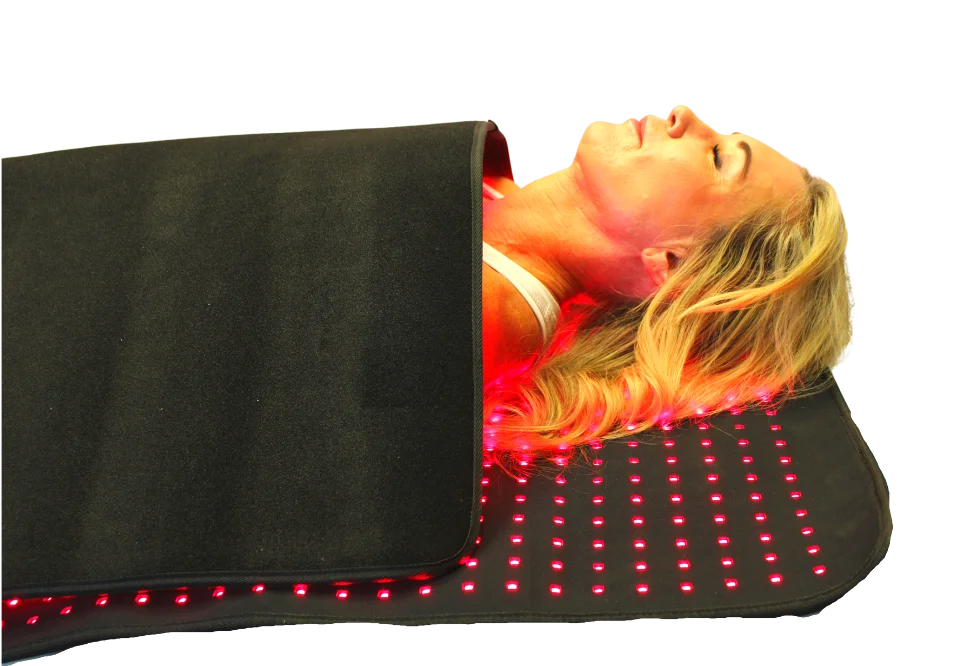Introduction to Light Therapy
Light therapy is a non-invasive treatment that uses specific wavelengths of light to penetrate the skin, helping to heal tissues, reduce pain, and improve blood flow. It’s also known as photobiomodulation (PBM), a process that stimulates healing at the cellular level, which can be especially helpful for conditions like peripheral neuropathy.
What is Peripheral Neuropathy?
Peripheral neuropathy is a condition where the nerves outside the brain and spinal cord are damaged, often due to diabetes, chemotherapy, infections, or other health issues. The symptoms can include:
- Tingling or numbness, especially in the hands and feet.
- Sharp, burning, or throbbing pain.
- Muscle weakness or loss of coordination.
- Increased sensitivity to touch or temperature changes.
These symptoms can be very uncomfortable, but light therapy for peripheral neuropathy offers a drug-free way to help manage them.
How Light Therapy Works for Peripheral Neuropathy
Light therapy works by using different wavelengths of light, such as red light therapy for peripheral neuropathy and infrared light therapy for peripheral neuropathy, to reach deep into the tissues. Here’s how it helps:
- Stimulates Cellular Energy Production: Light is absorbed by cells, boosting their energy production and helping them repair and regenerate. This process speeds up healing and helps nerve cells recover from damage.
- Reduces Inflammation: Light therapy helps reduce inflammation by increasing anti-inflammatory molecules, which is crucial for soothing the discomfort of peripheral neuropathy.
- Improves Blood Circulation: It stimulates the release of nitric oxide, which helps to expand blood vessels, ensuring better circulation and the delivery of oxygen and nutrients to damaged tissues.
- Encourages Nerve Regeneration: Light therapy activates pathways that support the growth of new nerve fibers and repair the protective covering of nerves, leading to nerve healing and pain relief.
- Modulates Pain Perception: By influencing nerve pathways, light therapy can help reduce nerve hypersensitivity, making pain more manageable.
Types of Light Therapy Devices for Peripheral Neuropathy
Light therapy utilizes a range of devices designed to deliver specific wavelengths of light to targeted areas of the body. These devices vary in their technology, intensity, and application, catering to different medical and personal needs. Below is a detailed explanation of the primary types of devices used for light therapy, particularly for managing peripheral neuropathy.
1. Infrared Light Devices
- How They Work:
- Infrared devices emit light in the near-infrared spectrum (typically 700–1200 nm), allowing deep tissue penetration. This makes them highly effective for conditions like peripheral neuropathy, where the damage is below the skin’s surface.
- Applications:
- Improves blood circulation and oxygen delivery.
- Targets deeper nerves and muscles for pain relief and healing.
- Advantages:
- Effective for large treatment areas, such as the legs and feet.
- Suitable for clinical and home use with appropriate training.
- Examples:
- Infrared therapy mats, handheld infrared devices, and advanced clinical equipment.
2. LED Light Therapy Devices
- How They Work:
- LED (Light Emitting Diode) devices emit light in specific wavelengths, commonly in the red (620–750 nm) and near-infrared (810–850 nm) ranges. These wavelengths stimulate cellular activity, reduce inflammation, and promote nerve regeneration.
- Applications:
- Widely used for pain relief, skin health, and neuropathy management.
- Portable and versatile, making them ideal for at-home treatments.
- Advantages:
- Safe, with minimal heat generation.
- Cost-effective and user-friendly.
- Examples:
- LED light panels, pads like the Prism Light Pad, and wearable devices tailored for targeted therapy.
3. Low-Level Laser Therapy Devices (LLLT)
- How They Work:
Low-Level Laser Therapy devices deliver focused laser light at low intensities, typically in the red and near-infrared spectrum. The precise targeting allows for deep penetration and localized stimulation of damaged tissues. - Applications:
- Often used in clinical settings for acute or severe cases of neuropathy.
- Effective for treating localized nerve damage and inflammation.
- Advantages:
- High precision and intensity for deeper therapeutic effects.
- Shorter treatment durations due to concentrated energy delivery.
- Disadvantages:
- Requires trained professionals for safe application.
- May be costlier compared to other devices.
- Examples:
Handheld lasers or clinical-grade laser therapy systems.
4. Prism Light Pad (Special Focus Device)
- How It Stands Out:
The Prism Light Pad combines the benefits of LED and infrared technology to provide a comprehensive solution for managing peripheral neuropathy. Its lightweight, portable design makes it suitable for both clinic and home use. - Key Features:
- Multiple light settings for targeted and customized treatments.
- Large coverage area for treating multiple zones simultaneously.
- FDA-approved for safety and efficacy.
- Benefits:
- Enhances blood circulation, nerve repair, and pain relief.
- Easy to use and suitable for daily sessions.
Light Therapy with the Prism Light Pad:
Light therapy is becoming a popular treatment for a range of health issues, from improving mood to helping with sleep problems. One device that has made light therapy easy and effective is the Prism Light Pad. This simple, portable tool uses light to help treat various conditions naturally and safely. In this article, we’ll explain why the Prism Light Pad is a great choice for light therapy.
Why Use the Prism Light Pad for Light Therapy?
The Prism Light Pad is a simple, portable device that uses light therapy to improve health naturally. Here’s why you should consider using it:
- Helps with SAD: The Prism Light Pad mimics natural sunlight, making it a great solution for Seasonal Affective Disorder (SAD), helping improve mood during dark winter months.
- Improves Sleep: Light exposure can reset your body’s internal clock, making it easier to fall asleep and sleep better.
- Boosts Energy and Mood: Exposure to bright light increases serotonin, helping you feel more energized and positive.
- Pain Relief: Light therapy can reduce pain and inflammation, offering relief for chronic pain conditions.
- Promotes Skin Health: The light stimulates collagen production, improving skin appearance and speeding up healing.
Benefits of Light Therapy
- Pain Relief and Reduced Inflammation: Light therapy helps reduce nerve sensitivity and alleviates pain. It also decreases inflammation in affected areas, which is crucial for managing peripheral neuropathy.
- Nerve Regeneration: By promoting cellular energy production and improving circulation, light therapy stimulates nerve repair, which can help restore feeling and coordination in the affected areas.
- Improved Mobility: As pain and inflammation reduce, patients experience better movement and can perform daily activities more easily.
- Drug-Free Option: Light therapy is non-invasive and does not rely on drugs, making it a safe and natural alternative to pain medications, reducing the risk of side effects and dependency.
- Convenient and Accessible: Devices like the Prism Light Pad allow for easy, at-home treatments, ensuring that therapy is accessible whenever needed.
How to Use Light Therapy for Peripheral Neuropathy
In a Clinic: If you’re seeking professional treatment, a healthcare provider will assess your condition and create a customized treatment plan. Clinical devices, like low-level laser therapy (LLLT) or infrared systems, offer higher precision and deeper penetration for severe cases. Treatment typically involves 2-3 sessions per week.
At Home: Devices such as the Prism Light Pad are designed for easy home use. You can follow the device instructions for daily treatments. A typical session lasts around 15-20 minutes, and you can treat areas like the feet, hands, or legs.
Precautions for Safe Use
While light therapy for peripheral neuropathy is generally safe, it’s important to follow these guidelines:
- Eye Protection: Always wear protective eyewear when using light therapy, especially for infrared or laser devices, to avoid eye damage.
- Skin Sensitivity: Some people may experience skin irritation. Start with a patch test to check for any reactions.
- Avoid Overuse: Stick to the recommended session lengths and frequency to avoid skin irritation or discomfort.
When to Consult a Healthcare Provider
Before beginning light therapy at home, it’s a good idea to consult a healthcare provider, especially if you have other medical conditions. If you notice any adverse effects, such as increased pain or skin irritation, or if your symptoms don’t improve after several weeks, consult a professional for guidance.
Conclusion
Light therapy, including red light therapy for peripheral neuropathy, infrared light therapy for peripheral neuropathy, and low-level light therapy for peripheral neuropathy, is a safe, non-invasive treatment that can significantly help manage the symptoms of peripheral neuropathy. By stimulating healing, reducing inflammation, and promoting nerve regeneration, it provides an effective solution to improve your quality of life without relying on medications. Whether you choose a device like the Prism Light Pad or seek treatment in a clinic, light therapy is a promising option for managing this condition.






